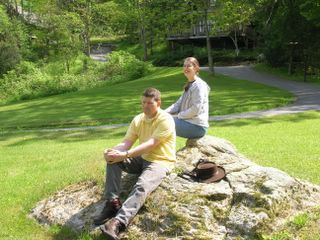Wednesday, June 22, 2005
Divine Intervention: It’s Natural!
Thus, I submit that we who claim the name of Christ should focus on the nature of God to provide us with a framework for tackling the question of special creation, of Divine intervention, of the God of Israel (YHWH) creating and relating to His creation. Therefore, I leave the questions regarding the literal account in Genesis for another time.
My examination turns to the Creator’s personal involvement in His creation today. For that the following text is useful:
Sing to the LORD with thanksgiving; make melody to our God on the lyre! He covers the heavens with clouds; he prepares rain for the earth; he makes grass grow on the hills. He gives to the beasts their food, and to the young ravens that cry. His delight is not in the strength of the horse, nor his pleasure in the legs of a man, but the LORD takes pleasure in those who fear him, in those who hope in his steadfast love.
(Psalms 147:7-11 ESV)
This excerpt is one of several examples that declare God is active in His creation. Notice that YHWH himself creates clouds and rain, and he makes grass grow. To accomplish that would require intimate understanding of atmospheric conditions and of the earth itself. Moreover, He feeds the animals both large and small. YHWH is personally involved in the most basic processes of animal life. From this text it would seem the Creator is not only seen as instrumental in the original creation, but He maintains all life and that which sustains life.
The Psalmist then shifts his focus from the animal kingdom to mankind and specifically on God’s covenant people—those who fear Him. Here special consideration and expectations arise. What is striking is the Lord taking pleasure on those who rely on him in fear. There seem to be no expectations from the animals to respond to the Creator, yet YHWH takes pleasure in those who place their trust in His provision.
At the same time He does not delight in man’s own effort to make a life for himself: “His delight is not in the strength of the horse, nor his pleasure in the legs of a man” (verse 10). Yes, man should work (the Bible is clear that laziness is discouraged), and I think in this context the horse's strength corresponds to man's use of the animal. Yet God delights when man recognizes that the fruit of our labor as coming from God. NASB renders verse 11b “Those who wait for His lovingkindness.” Thus, the text encourages us to recognize YHWH as the loving provider and for us to wait on the Lord.
The Hebrew word used in verse 11 is chêsêd (pronounced kheh'-sed). It describes God’s goodness, kindness, faithfulness. It is found 246 times in the Old Testament (NASB):
deeds of devotion 2, devotion 1, devout 1, faithfulness 1, favor 2, good 1, kindly 7, kindness 32, kindnesses 1, loveliness 1, lovingkindness 176, lovingkindnesses 7, loyal deeds 1, loyalty 6, mercies 1, merciful 2, mercy 1, righteousness 1, unchanging love 2
(http://bible.crosswalk.com/Lexicons/Hebrew/heb.cgi?number=02617&version=nas)
It is the loving faithfulness of YHWH for those who fear Him that proves God is active and working in His creation every day. When one reads the biblical stories of YHWH and His dealings with the world, man, and His chosen people with whom He made covenants of promise, one can readily see YHWH regards His creation with love and faithfulness. Moreover, there are countless followers of the Messiah who can testify to God’s lovingkindness and faithfulness in their daily lives and specific circumstances.
As history unfolds and the remaining promises are fulfilled completely, there will be no doubt that God’s design was not only to create but to relate to His creation and the debate will be over. Regardless of whatever scientific research may assert, we must set our faith in YHWH and recognize his lovingkindness and faithfulness to the universe, world, nations, communities, and individuals who “fear him” and “hope in his steadfast love.”
Tuesday, June 07, 2005
Worship Wars: Revenge of the Serpent
As the message of reconciliation spread out, the world witnessed a cause an outsider might consider lost. How could a fugitive band of rebels produce such inroads into Rome itself? Yet this message did move out, “bearing fruit and growing all over the world” (Colossians 1:6b), and those being saved responded to God’s wondrous grace in worship of the Redeemer and pledged their lives to His service.
Yet the dark lord did not take defeat well and he hatched a plan to sidetrack the mission of the church by inciting civil war within. In the early days of the war, false teachers slipped into the church and created division. Factions arose and derided the apostles and the gospel itself. Those seeking personal glory found some success in leading Christian warriors astray. After a few centuries the dark days of tyrannical church rule fell on much of the world and held the pure gospel message captive in its grip.
Nearly a thousand years later the Reformation emerged as a group of freedom fighters rallied around the foundation of biblical truth, and the gospel message resumed its mission. While initially relegated to northern territories in Europe, the Reformation grew and millions joined the cause and rediscovered worship and mission.
Once again that old serpent was not long held at bay and he plotted to destroy the church from within. More and more believers split over doctrinal differences, and worship itself became a tool for emphasizing those splits. By the twentieth century the world would have hundreds of sects all pursuing separate goals and worshipping within their clouded convictions and cultures.
Not content to merely split the larger church itself, the serpent instigated division within local churches by means of the generation gap and disputes over style of music. Satan realized that he could disable the churches if its people could not attain unity within their own congregations. This tactic has now resulted in fragmented churches with “traditional” and “contemporary” services (whatever those mean), and in the 21st century we see this separatist trend being amplified within many Christian sectors. Even now the battle over worship, its form, function, and focus is taking our eyes off of the primary mission and from the Lover of our souls.
We are at war. The stakes are high. Our dim view of the Most High and our focus on the mundane and temporary has blinded us. It is time for us to rediscover the real Force: the Holy Spirit at work within us where we are “speaking to one another in psalms, hymns, and spiritual songs, singing and making music to the Lord in [our] hearts, giving thanks always for everything [without grumbling] to God the Father” where we should “submit to one another in the fear of Christ” (Ephesians 5:19-21)...
...and the saga continues. Let us pray and work towards the next episode where God is glorified in our lives, and where the world once again marvels at this "foolish" gospel.
Saturday, June 04, 2005
The Church and Culture: Who’s Leading Who?
The 21st century finds the western church attempting to redefine itself (again). We have witnessed immeasurable change in our world in last two centuries, and the church right along with it. All one has to do is search the Internet for words like ‘Emerging Church,’ ‘worship wars,’ and ‘gay marriage’ or visit web sites like Christianity Today and Lifeway (just to name a few) to see the myriad challenges facing the church.
For instance, Lifeway surveyed “more than 1,300 ministry leaders from Europe,
Christianity Today seems to address even broader, cultural and inter-denominational topics (e.g. Roman Catholic-Evangelical dialogue, inter-faith ecumenicalism, popular culture and ‘culture wars’, ‘worship wars’, globalization, etc.). These issues seem to face the larger, universal church throughout the world (the universal church defined as the spiritual church that includes all true believers throughout the world).
Within this very limited examination (there are many more websites, books, and periodicals devoted to the aforementioned topics), the careful observer should recognize how the culture seems to drive the church on many of these issues. This is not a new development. Indeed, any study of church history would reveal the repetition of the culture overtaking the church in virtually every aspect. From almost the earliest days the Christian church has flirted with the world with disastrous results. However, with the increasing pace of change in our world the church is struggling to respond and the affects of culture are more pronounced.
Enter the so-called
This alternative model reflects the bold, brash, techno-savvy, postmodern culture of the 21st century. The desire seems to be centered on finding a fresh, new way to be the church for a postmodern world. While I am sympathetic to the problems and failures of the church (both local and universal), I do not believe this discussion and new model will bring about spiritual renewal. Moreover, I submit that it is really the same OLD idea of culture driving the church.
Just how old is this problem, and what might be the solution? Luke 10:25-37 may offer a clue. It is the familiar story of the ‘Good Samaritan’. An expert in the Law of Moses tested Jesus by asking: "what must I do to inherit eternal life?" 26 "What is written in the law?" He asked him. "How do you read it?" 27 He answered: You shall love the Lord your God with all your heart, with all your soul, with all your strength, and with all your mind; and your neighbor as yourself. 28 "You've answered correctly," He told him. "Do this and you will live."
Jesus knew this man’s real intention. This expert was a lawyer hoping to trap Jesus by his argument. The lawyer responded "And who is my neighbor?"
30 Jesus took up the question and said: "A man was going down from
Jesus’ parable refutes the lawyer and it underscores verse 27 by showing how we are to demonstrate our love to God and our neighbor. The normal interpretation rightly highlights the historical enmity between Samaritans and Jews, showing the Samaritan to be a man of compassion and mercy while overcoming the shame of being a despised foreigner. Additionally, that loving mercy is contrasted against the deplorable, self-righteous attitude of the “professional” religious men who disregarded the desperate man. Thus, the Samaritan illustrated how one is to love God and man, the epitome of God’s law of life.
It is within the two paradigms of personal behaviors shown in this parable that one can observe the failure of the church, both historically and today, and at the same time see the simple solution offered by Jesus himself: love God with everything you have, and risk everything you have for each other.
Matthew 22:34-40 supports this by declaring that our total love towards God and our neighbor supports all other religious activity. If we truly love God and people, we will set aside our pride, endure shame, and find common ground between all who are in Christ. If we do this the church will take its proper place as leading the culture back to God instead of the culture leading the church astray. “And they’ll know we are Christians by our love…”




